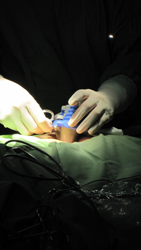 The trend in surgical techniques is towards developing the least invasive methods to perform surgical procedures. It is believed this will result in not only better cosmetic results, but also less pain and faster recovery for the patient. The trend in surgical techniques is towards developing the least invasive methods to perform surgical procedures. It is believed this will result in not only better cosmetic results, but also less pain and faster recovery for the patient.
Laparoscopy is a minimally invasive surgical procedure which utilizes several small incisions in the abdomen to insert a viewing instrument, the laparoscope, and tiny surgical instruments. Laparoscopy is used to diagnose and treat a wide range of problems within the abdominal and pelvic cavities. It differs from traditional "open" surgery which utilizes one large incision to access the abdomen.
The latest advancement in laparoscopic surgery is a new surgical technique called single incision laparoscopy that is performed through only one incision, usually through the belly button. This new technique may be referred to by many names including:
- SILS: Single incision laparascopic surgery
- SPA: Single port access
- LESSS: Laparoscopic endoscopic single site surgery
- SLIT: Single laparoscopic incision transabdominal surgery
- OPUS: One port umbilical surgery
- NOTUS: Natural orifice transumbilical surgery
- E-Notes: Embryonic natural orifice transumbilical endoscopic surgery
- Scarless Surgery
What is Single Incision Laparoscopy?
Single incision laparoscopy is a minimally invasive surgical procedure performed through one incision, usually at the umbilicus (belly button), enabling your surgeon to look inside the abdominal and pelvic cavities to diagnose and treat a variety of abnormal conditions.
Normally, laparoscopy is performed through multiple tiny incisions in the abdomen. The surgeon then inserts a hollow tube called a trocar in the incisions through which the laparacope and surgical instruments are inserted.
A laparoscope is a long, narrow telescope with a light source and video camera at the end. Images from the camera are projected onto a large monitor for the surgeon to view the abdominopelvic cavity.
Laparoscopes have channels inside the scope enabling the surgeon to pass gas in and out to expand the viewing area or to insert tiny surgical instruments for treatment purposes. The surgical instruments used in operative laparoscopy are very small but appear much larger when viewed through a laparoscope.
With single incision laparascopy, your surgeon makes one incision through the umbilicus and then inserts multiple tiny trocars through the one incision to perform the surgery.
Advantages of Single Incision Laparoscopy
Research studies are ongoing to assess the outcomes of single incision laparoscopy compared to traditional laparoscopy but early studies are confirming that "smaller is better" when it comes to incisions.
Some advantages that may be obtained from undergoing single incision laparoscopy include:
- No visible scar
- Shorter hospital stay
- Decreased post operative pain
- Faster return to work
Single Incision Laparoscopy is usually performed as day surgery either in the hospital or outpatient surgery center under general, regional, or occasionally local anesthesia depending on the type of procedure performed and the surgeon’s preference.
During SILS, the patient is placed lying on their back with their body tilted so the feet are higher than the head. This position helps to move some of the abdominal organs toward the chest allowing the surgeon a clearer view. Your legs may be straight or split apart depending on the surgery and your surgeon’s preference on where to stand during the operation.
- The surgeon makes a small incision in the abdomen, usually at the belly button.
- The surgeon injects a harmless gas into the abdominal cavity to expand the viewing area of the abdomen giving the surgeon a clear view and room to work.
- The surgeon then inserts a tube called a trocar followed by the other trocars in the same incision.
- The laparascope and tiny surgical instruments can then be inserted through the trocars to perform the particular surgery.
- With the images from the laparoscope as a guide, the surgeon can look for any pathology or anomaly.
- The large image on the television screen allows the surgeon to see the abdominal contents directly and to determine the extent of the problem, and then perform the particular surgical procedure.
- After treating the problem, the laparoscope and other instruments are removed and the gas released.
- The tiny incision is closed and covered with a small bandage.
Single Incision Laparoscopy is much less traumatic to the muscles and soft tissues than the traditional method of surgically opening the abdomen with long incisions (open techniques).
|


